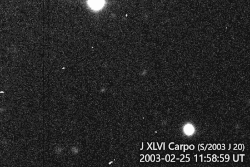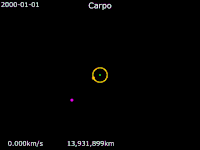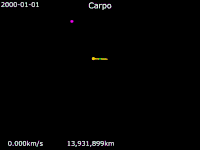Carpo (moon)
Carpo /ˈkɑːrpoʊ/, also Jupiter XLVI, is a natural satellite of Jupiter. It was discovered by a team of astronomers from the University of Hawaii led by Scott S. Sheppard in 2003, and was provisionally designated as S/2003 J 20[2][3] until it received its name in early 2005.[4]
 Carpo imaged by the Canada-France-Hawaii Telescope on 25 February 2003 | |
| Discovery | |
|---|---|
| Discovered by | Scott S. Sheppard et al. |
| Discovery date | 2003 |
| Designations | |
Designation | Jupiter XLVI |
| Pronunciation | /ˈkɑːrpoʊ/ |
Named after | Καρπώ Karpō |
| S/2003 J 20 | |
| Adjectives | Carpoan /kɑːrˈpoʊən/ or Carpoian /kɑːrˈpoʊ.iən/ |
| Orbital characteristics [1] | |
| 16989000 km | |
| Eccentricity | 0.430 |
| +456.1 days | |
| 242.8° | |
| Inclination | 51.4° |
| 60.9° | |
| 90.0° | |
| Satellite of | Jupiter |
| Group | (own group) |
| Physical characteristics | |
Mean diameter | 3 km |
| 23.0 | |
Carpo is about 3 kilometres (1.9 miles) in diameter, and orbits Jupiter at an average distance of 17.145 Gm (just over ten million miles) in 458.625 days, at an inclination of 56° to the ecliptic (55° to Jupiter's equator), and with a high eccentricity of 0.4316.
It was named in March 2005 after Carpo, one of the Horae, and a daughter of Zeus (Jupiter).
Like Themisto and Valetudo, this moon seems to be the lone member of a unique class, which makes it particularly interesting. The orbital inclination of satellites such as this one is limited by the Kozai effect, discovered by Yoshihide Kozai in 1962. This effect induces a periodic exchange between the inclination and eccentricity of the orbit; if the inclination is large enough, the eccentricity can in turn grow so large that the periapsis of the satellite (called the perijove in the case of moons of Jupiter) would be in the immediate vicinity of the Galilean moons (Io, Europa, Ganymede and Callisto). The satellite would eventually collide with one of these, or a close encounter would eject it altogether from the Jovian system. The periapsis precession period (Pw) is 6.8 million years long.[5]


References
- S.S. Sheppard (2019), Moons of Jupiter, Carnegie Science, on line
- Daniel W. E. Green (April 30, 2003). "IAUC 8125: S/2003 J 19 and S/2003 J 20". International Astronomical Union. Archived from the original on 2016-03-05.
- MPEC 2003-G67: S/2003 J 20 2003 April (discovery and ephemeris)
- Daniel W. E. Green (March 30, 2005). "IAUC 8502: Satellites of Jupiter". International Astronomical Union.
- Jacobson, R. A. (2006) JUP262 (2007-06-28). "Planetary Satellite Mean Orbital Parameters". JPL/NASA. Retrieved 2008-01-19.